Rattlesnakes are venomous reptiles that you should avoid as much as possible. While some species deliver less harmful bites, any rattlesnake bite can turn fatal quickly.
Most rattlesnake species have several features despite their differences. They have heat-sensing organs to help them find prey, venom glands to deliver a toxic bite, and of course, a rattle on their tail. Most rattlesnakes will use their loud rattle before they strike, warning you and giving you time to get away.
How Many Kinds of Rattlesnakes Are There?
At one point, there were about 45 rattlesnakes species and over over 50 subspecies. However, scientists have been hard at work with genetic testing to determine how accurate the species were classified. They discovered that there are currently over 50 species, and as they learn more, that number changes.
Which Rattlesnakes Live in North America?
Over 20 rattlesnake species are located in North America, but several were originally classified as subspecies of others — like the western rattlesnake and massasauga.
1. Timber Rattlesnake
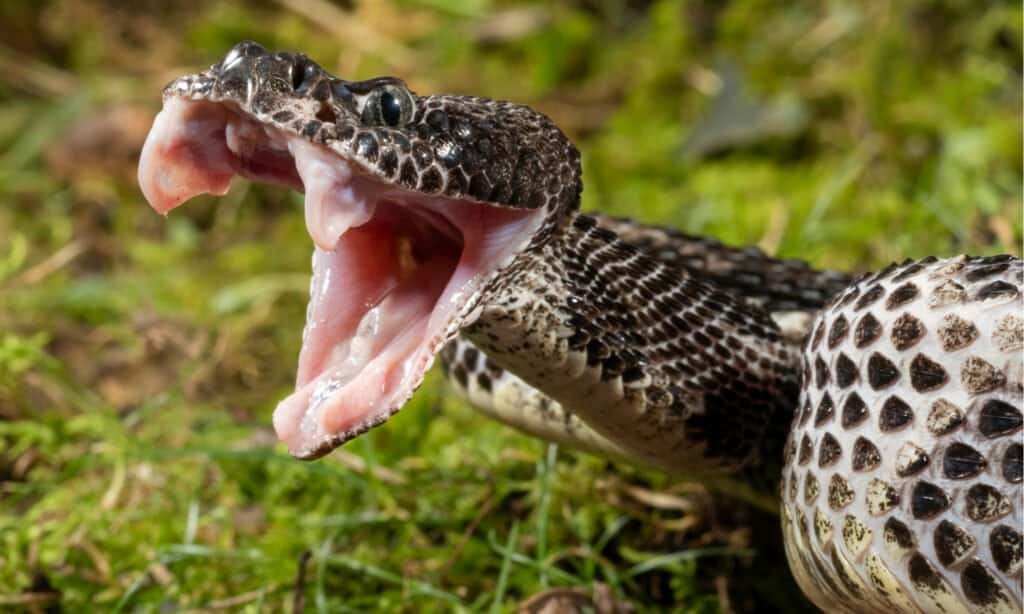
©Joe McDonald/Shutterstock.com
The timber rattlesnake is one of the most common rattlesnake species in North America. It is the only rattlesnake, and one of only 2 venomous snakes, in the Northeastern United States. Their habitat stretches all the way from Minnesota to Florida. These snakes have an extremely venomous bite but are less likely to bite than some other rattlesnake species. They tend to give you plenty of time to get away with fake strikes and lots of rattling before they actually bite.
Timber snakes have been responsible for a large percentage of fatal snake bites between 1989 and 2018. In that time, 22 people died from timber rattlesnake bites. However, that may just be because they are more common than other species.
- Scientific name: Crotalus horridus
- Other names: canebreak rattlesnake and banded rattlesnake
- They grow to between 30 and 60 inches long
- The longest timber rattlesnake ever observed was 74.5 inches long
- They weigh up to 3.3 pounds
- The timber snake is the state reptile of West Virginia
- They eat small animals like frogs, other snakes, birds, and rodents
2. Eastern Diamondback Rattlesnake
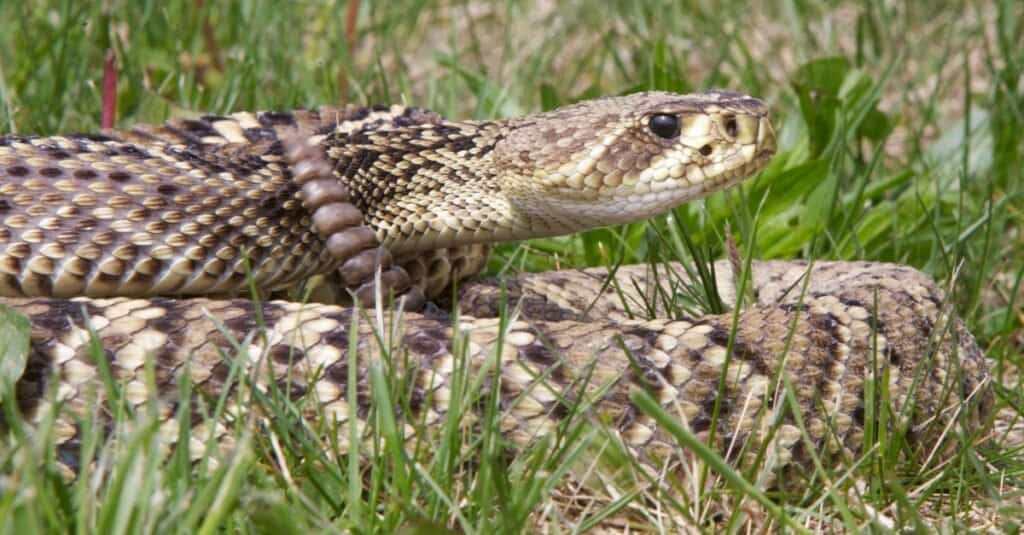
©iStock.com/NajaShots
The Eastern Diamondback Rattlesnake is the largest rattlesnake ever. This species is found in the southeastern part of the United States, ranging from North Carolina to Florida. While they are not very aggressive, they are quite dangerous. In proportion to their body, they have some of the longest fangs of any venomous snake. The mortality rate from an eastern diamondback bite is estimated to be anywhere from 10-30%.
- Scientific name: Crotalus adamanteus
- Other names: diamond rattlesnake, common rattlesnake, Florida rattlesnake, lozenge-spotted rattlesnake, and water rattlesnake
- Eastern diamondbacks grow between 3.5 and 5.5 feet on average
- The longest eastern diamondback rattlesnakes ever reported were over 8 feet
- The longest eastern diamondback rattlesnake ever observed was 7.8 feet
- They weigh about 5 pounds on average
- The heaviest diamondback rattlesnake ever observed was 34 pounds
- They eat rabbits, mice, birds, and other small animals
3. Western Diamondback Rattlesnake

©Alexander Wong/Shutterstock.com
This rattlesnake species is found in the Southwestern United States and Mexico. They range from central California east to Arkansas, and south into Sinaloa, Mexico. The western diamond rattlesnake is the second largest rattlesnake in the United States. The western diamondback has larger venom glands than many other venomous snakes. Because of this, they can deliver a fierce bite. The fatality rate of an untreated western diamondback bite is between 10 and 20 percent.
- Scientific name: Crotalus atrox
- Other names: Texas diamond-back, adobe snake, Arizona diamond rattlesnake, desert diamondback
- They grow 4 feet long on average
- The longest western diamondback ever seen was 7 feet long
- They mainly eat small mammals like prairie dogs, gophers, rats, and mice
4. Twin Spotted Rattlesnake

©iStock.com/adogslifephoto
This is a small rattlesnake species with 2 subspecies: the eastern twin-spotted rattlesnake and the western twin-spotted rattlesnake. The eastern variety is found in Mexico. The western variety is found in Southeastern Arizona, and Sonora, Chihuahua, and Durango in Mexico. This rattlesnake is rather shy and doesn’t bite humans very often.
- Scientific name: Crotalus pricei
- Other names: Price’s rattlesnake, spotted rattlesnake, Arizona twin spotted rattlesnake
- They grow between 20 and 24 inches long
- The longest twin spotted rattlesnake ever recorded was 26 inches long
5. Western Rattlesnake
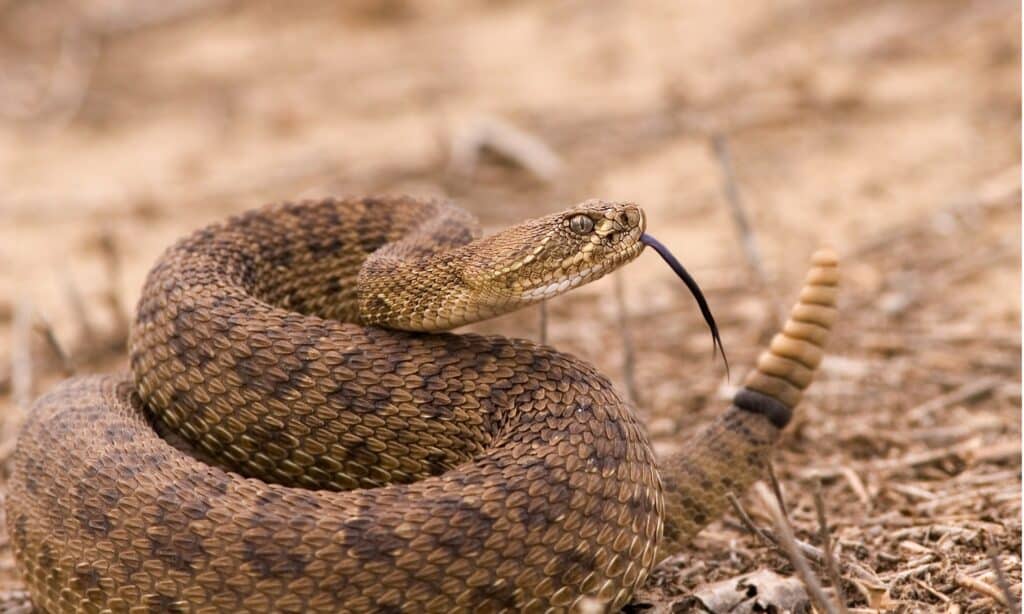
©iStock.com/SteveMcsweeny
Until the early 2000s, there were 5 different subspecies of the western rattlesnake. However, modern genetic testing shows that they’re more genetically diverse than that. Here they are, with their current scientific names:
- Southern Pacific rattlesnake (Crotalus helleri)
- Northern Pacific rattlesnake (Crotalus oreganus)
- Grand Canyon rattlesnake (Crotalus oreganus abyssus)
- Midget faded rattlesnake (Crotalus concolor)
- Great Basin rattlesnake (Crotalus lutosus)
These snakes can be found in Western North America from Southern Canada to Northern Mexico.
- Scientific name: Various, but they were all subspecies of Crotalus oreganus
- The average length is between 15 and 36 inches
- The longest western rattlesnake ever observed was 60 inches long
- Has special heat-sensing organs that it uses to hunt prey
- Diet consists of birds, bird eggs, and small animals like rabbits
6. Pygmy Rattlesnake
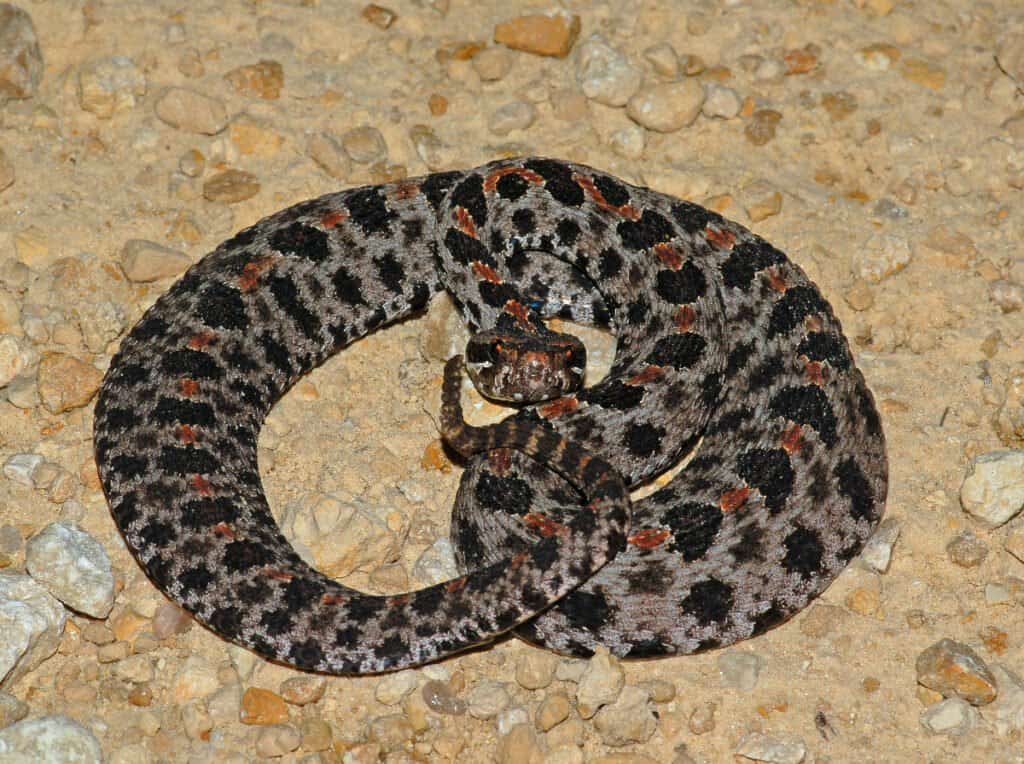
©Gerald A. DeBoer/Shutterstock.com
There are three subspecies of pygmy rattlesnake:
- Dusky pygmy rattlesnake (Sistrurus miliarius barbouri)
- Carolina pygmy rattlesnake (Sistrurus miliarius millarius)
- Western pygmy rattlesnake (Sistrurus miliarius streckeri)
Pygmy rattlesnakes are a small variety of rattler. These snakes are found in the Southeast of the US and range from North Carolina to Florida. They are found as far west as Oklahoma and Texas. They are not very dangerous to humans. They don’t give a lot of venom in a bite, so even if one does strike, it’s unlikely to be fatal. However, you should still seek medical care if you get bitten.
- Scientific name: Sistrurus miliarius
- Other names: eastern pygmy rattlesnake, ground rattlesnake, leaf rattler, death rattler, hog-nosed rattlesnake, little rattlesnake, miliar rattlesnake, North American smaller rattlesnake, oak-leaf rattler, bastard rattlesnake, nipple snake, Catesby’s small snake
- They usually grow between 16 and 24 inches long
- The longest pygmy rattlesnake ever found was 31 inches long
- They eat giant desert centipedes, birds, lizards, bugs, and small mammals
- The drug eptifibatide, which can prevent blood clots during a heart attack, is based on the snake’s unique venom which contains serotonin
7. Ridge-Nosed Rattlesnake

©Matt Jeppson/Shutterstock.com
There are 5 subspecies of ridge-nosed rattlesnakes:
- Del Nido ridge-nosed rattlesnake (Crotalus willardi amabilis)
- Southern ridge-nosed rattlesnake (Crotalus willardi meridionalis)
- New Mexico ridge-nosed rattlesnake (Crotalus willardi obscurus)
- Chihuahuan ridge-nosed rattlesnake (Crotalus willardi silus)
- Arizona ridge-nosed rattlesnake (Crotalus willardi willardi)
The ridge-nosed rattlesnake was the last rattlesnake species to be identified in the US. The snake lives mainly in high elevation areas in southeastern Arizona and parts of Mexico. As smaller snakes, they are not likely to deliver a fatal bite, though it would still be an uncomfortable experience!
- Scientific name: Crotalus willardi
- Other names: Willard’s rattlesnake and Willard’s rattler
- They are between one and two feet long
- The ridge-nosed rattlesnake is the state reptile of Arizona
- They eat large desert centipedes, birds, and small mammals
8. Sidewinder
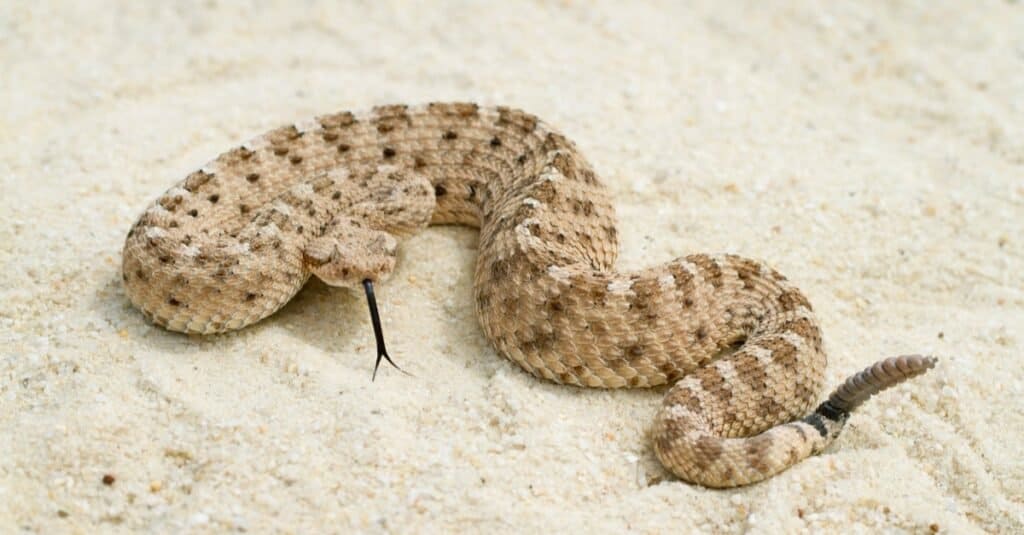
©Mark_Kostich/Shutterstock.com
There are 3 subspecies of sidewinders:
- Mojave Desert sidewinder (Crotalus cerastes cerastes)
- Sonoran Desert sidewinder (Crotalus cerastes cercobombus)
- Colorado Desert sidewinder (Crotalus cerastes laterorepens)
This species is named for its unique pattern of movement across the desert sand. It appears to slide easily sideways across the open terrain. They are found in the Southwestern United States and Northern Mexico. As a smaller rattlesnake with a small venom gland, a bite is not likely to be fatal, but will definitely be painful. A 1997 account of a small sidewinder bite on a finger said that even with anti-venom, after 2.5 hours, the patient’s entire arm was swollen!
- Scientific name: Crotalus cerastes
- Other names: horned rattlesnake and sidewinder rattlesnake
- Sidewinders can travel at up to 18 miles per hour
- Adults are between 20 and 30 inches long
- Males in most rattlesnake species are larger than females, but sidewinder females are larger than males
9. Massasauga Rattlesnake

©Rusty Dodson/Shutterstock.com
There’s some debate on the massasauga scientific naming. Until recently, there were three accepted subspecies. Now, we have two species plus two subspecies, including the nominate subspecies. This may change, as some scientists believe that the desert massasauga should be elevated to full species.
- Eastern massasauga (Sistrurus catenatus catenatus)
- Desert massasauga (Sistrurus tergeminus edwardsii)
- Western massasauga (Sistrurus tergeminus)
This rattlesnake is found in the Central United States. Their range stretches from Southern Ontario to Arizona. They avoid people, so most snake bites by this species happened to people who were deliberately handling a snake or who were walking barefoot outside and accidentally stepped on a snake.
While the species is listed as “least concern” on the IUCN Red List, the eastern massasauga is considered endangered in several US states. It is also considered to be regionally extinct (extirpated) in Missouri.
- Scientific name: Sistrurus catenatus and Sistrurus tergeminus
- Other names: massasauga rattlesnake, black massasauga, black snapper, gray rattlesnake, muck rattler, swamp rattler, víbora de cascabel, Kirtland’s rattlesnake, Michigan point rattler, swamp massasauga, triple-spotted rattlesnake
- They average 24-36 inches long
- They eat insects, reptiles, and small mammals
10. Rock Rattlesnake
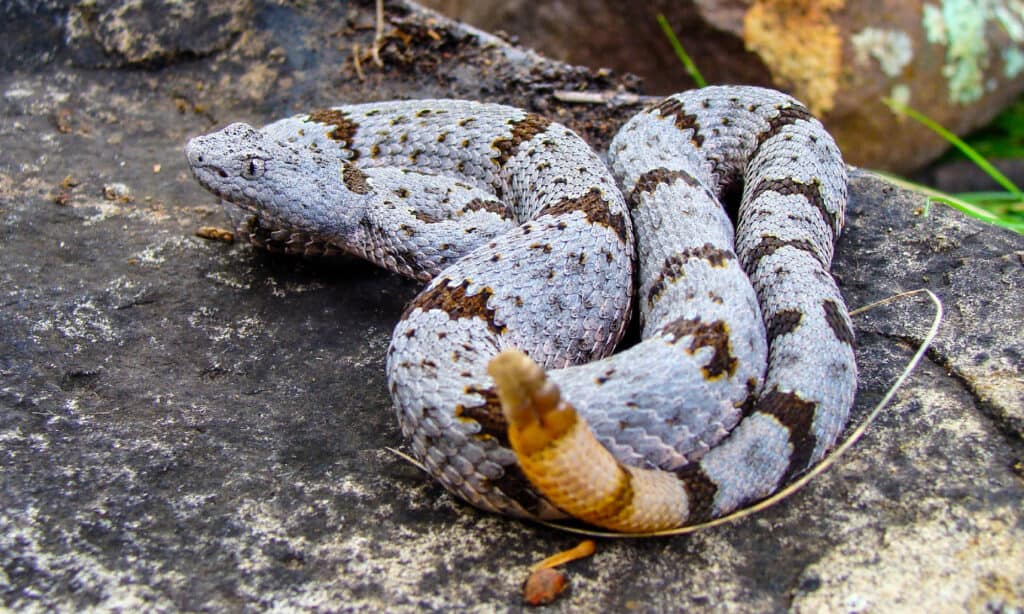
©Matt Jeppson/Shutterstock.com
There are 3 subspecies of rock rattlesnake:
- Banded rock rattlesnake (Crotalus lepidus klauberi)
- Mottled rock rattlesnake (Crotalus lepidus lepidus)
- Durango rock rattlesnake (Crotalus lepidus maculosus)
The rock rattlesnake is another smaller species of viper. It is found in a few southern US states including Arizona, New Mexico, and Texas, as well as a large area of central Mexico. This type of snake is not very aggressive. However, they are very good at camouflaging themselves in their rocky habitat. So, intrepid hikers may accidentally step on one or touch one while navigating a rock scramble or climb, provoking a bite.
- Scientific name: Crotalus lepidus
- Other names: blue rattlesnake, eastern rock rattlesnake, green rattlesnake, Texas rock rattlesnake, white rattlesnake
- They are no more than 32 inches long
- They are named for their habitat: rocky areas
- They can survive in colder temperature areas than other rattlesnake species
- They eat lizards, small mammals, and frogs
11. Mojave Rattlesnake

©Creeping Things/Shutterstock.com
Mojave rattlesnakes have one of the most dangerous snakebites in North America. There are 2 subspecies:
- Mojave rattlesnake (Crotalus scutulatus scutulatus)
- Humantla rattlesnake (Crotalus scutulatus salvini)
The reason their venom is so dangerous is that it has both neurotoxic and hemotoxic properties. Most snake venoms have either one or the other. Neurotoxins affect the nervous system and hemotoxins affect your blood either by killing red blood cells, causing or preventing blood clots, and degenerating organs. So, a bite that has both has more than one way to hurt you.
The Mojave rattlesnake is found in the southwest US, and its range stretches through Mexico to Puebla. If you see one that is dead, don’t pick it up! People have done so and gotten accidentally pricked by its fangs, which still delivered a dose of venom.
Luckily, if you do get bitten, antivenin is extremely effective in treating Mojave rattlesnake bites. In our modern era, there are rare fatalities from this snake. Before the invention of antivenin, the mortality rate was estimated to be between 5% and 25%.
- Scientific name: Crotalus scutulatus
- Other names: Mojave green
- They grow about 3 feet long on average
- Mojave rattlesnakes eat birds, small mammals, and lizards
12. Speckled Rattlesnake
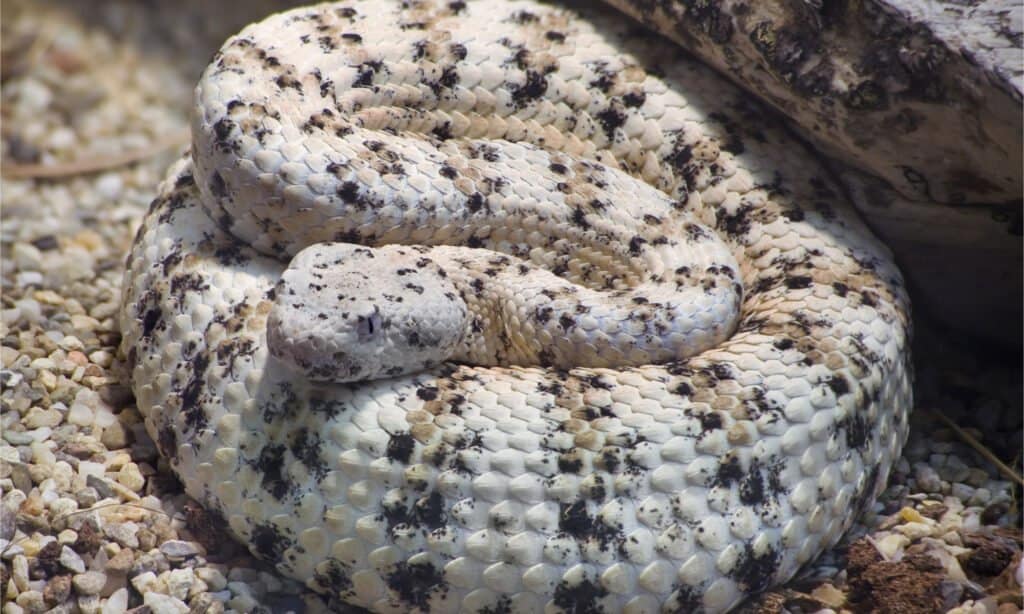
©Dario Sabljak/Shutterstock.com
There are at least 3 subspecies of the speckled rattlesnake:
- San Lucan speckled rattlesnake (Crotalus mitchellii mitchellii)
- El Muerto Island speckled rattlesnake (Crotalus mitchellii muertensis)
- Southwestern Speckled Rattlesnake (Crotalus mitchellii pyrrhus)
There were other subspecies, but scientists argue that those are different enough to merit being their own separate species.
The speckled rattlesnake is found in the Southwestern US including California, Nevada, Utah, and Arizona. It is also present in Mexico, mostly in Baja California.
- Scientific name: Crotalus mitchellii
- Other names: Mitchell’s rattlesnake, white rattlesnake
- The scientific name comes from a doctor, S.W. Mitchell, who did research on snake venom
- They tend to eat lizards and rodents more often than birds
13. Black-Tailed Rattlesnake
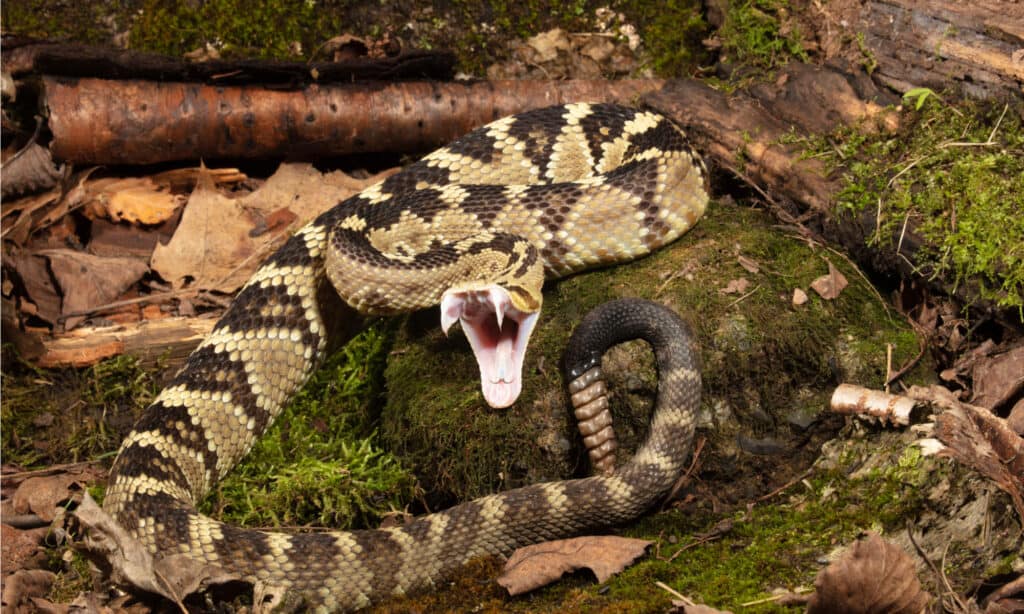
©Joe McDonald/Shutterstock.com
There are 3 subspecies of the black-tailed rattlesnake, mostly differentiated by where they are found.
- Northern black-tailed rattlesnake (Crotalus molossus molossus)
- Mexican black-tailed rattlesnake (Crotalus molossus nigrescens)
- Oaxacan black-tailed rattlesnake (Crotalus molossus oaxacus)
The northern black-tailed rattlesnake is found in the United States, in Arizona, Texas, and New Mexico, as well as parts of Mexico. The other 2 subspecies are only found in Mexico.
If you do see one of these rattlers, you will be glad to know they are one of the least likely to strike and bite. They will only use their rattle to warn before a bite if they feel they are trapped. Otherwise they usually just try to escape a hairy situation. Their venom is also less toxic than some other rattlesnakes. however, because of this, they do deliver a larger amount of venom with each bite. Even though black-tailed rattlesnake bites are not likely to be fatal you should still seek treatment if bitten.
- Scientific name: Crotalus molossus
- They can easily be identified by their all black tails
- They are nocturnal in the summer, but in spring and fall they are most active during the day
- They are usually between 30 and 40 inches
- The largest black-tailed rattlesnake ever seen was 49.2 inches long
- They have a usual rattlesnake diet of small mammals and lizards
14. Panamint Rattlesnake
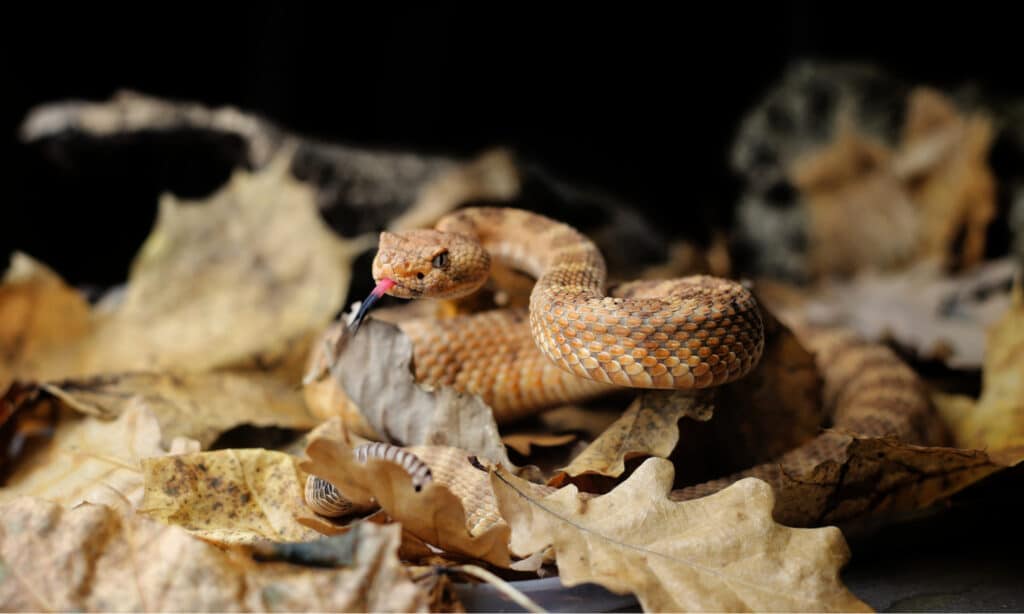
©Marina Kehl/Shutterstock.com
These snakes are found in California and Nevada between elevations of 3,000 and nearly 8,000 feet. The scientific name is in honor of Frank Stephens, a former curatus emeritus of the San Diego Society of Natural History. He was on the expedition where this snake was first identified.
- Scientific name: Crotalus stephensi
- Other names: Owen’s Valley rattler, tiger rattlesnake (but not to be confused with the tiger rattlesnake below!)
- They grow 2-3 feet long on average
- Babies are about 10 inches long when born
- They eat small mammals, birds, and lizards
- They get their common name from the Panamint Mountains in Death Valley National Park
- Their other name, Owen’s Valley rattler comes from Owen’s Valley in the Eastern Sierra Mountains where they are also found
15. Tiger Rattlesnake
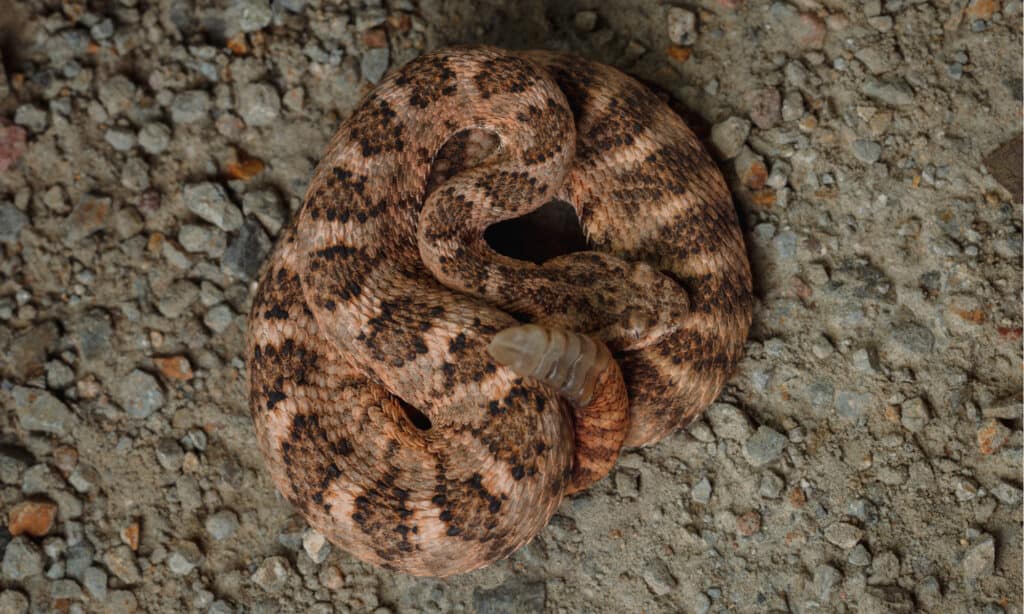
©Alexander Wong/Shutterstock.com
The tiger rattlesnake gets its name from the appearance of stripes. It is found in Arizona and Mexico. These snakes are not the most active. One study showed that on average, the snakes move only 108 feet per day during their most active season.
The tiger rattlesnake has the second most toxic venom of any rattlesnake and of any kind of snake in the Western Hemisphere. The most toxic is the Mojave rattlesnake. Tiger rattlers don’t strike that often, but when they do, their bites can cause death of muscle tissue. However, their bites don’t deliver that much venom. So, they may not be fatal unless the person that got bitten is a child or smaller person.
- Scientific name: Crotalus tigris
- It has the smallest head of all rattlesnake species
- They are 2 feet long on average
- They primarily eat small rodents but can also eat lizards
16. Prairie Rattlesnake
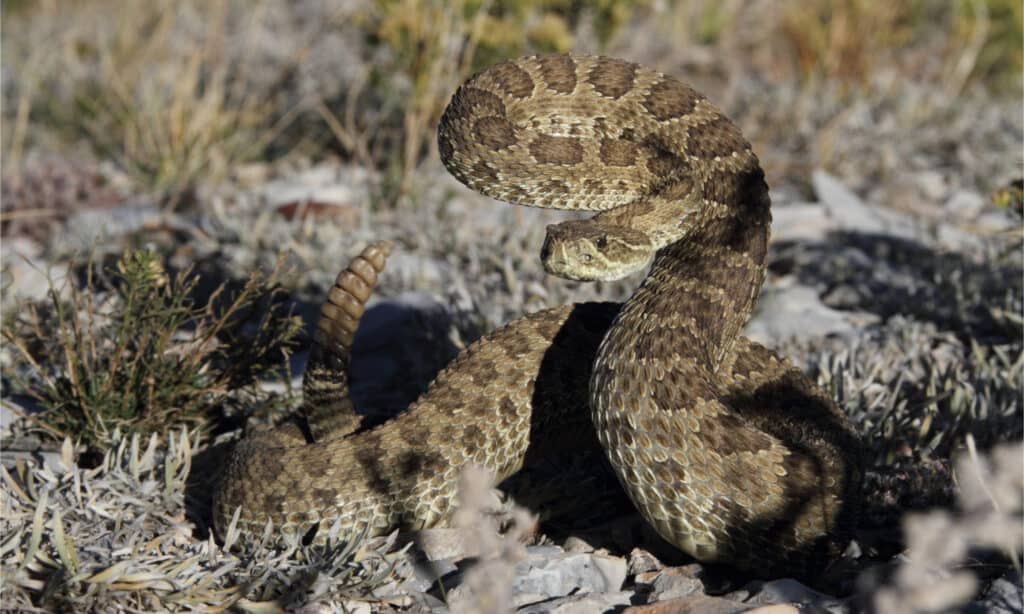
©Harris Motion Photo/Shutterstock.com
There are 2 subspecies of the prairie rattlesnake, which mostly signify the snake’s location:
- Prairie rattlesnake (Crotalus viridis viridis)
- Hopi rattlesnake (Crotalus viridis nuntius)
There used to be many more subspecies, but after more research, scientists determined they were either their own species or subspecies of other types of rattlesnakes.
These snakes are found in the midwest of the US as well as the Rocky Mountains and southwest. They are also found in two provinces in Canada: Saskatchewan and Alberta. They are also present in northern Mexico.
One unique fact about this type of snake—it can deliver a bite with no venom. In general, they are pretty shy and hide out during the day. They only come out to feed in the cooler morning. They only strike if bothered.
- Scientific name: Crotalus viridis
- Other names: Great Plains rattlesnake, Arizona prairie rattlesnake
- The largest prairie rattlesnake on record is nearly 5 feet long
- They grow on average to be a bit more than 3 feet long
- Due to their wide habitat, they have large variety of small mammals in their diet
- They have the largest habitat of any rattlesnake in the US
17. Red Diamond Rattlesnake
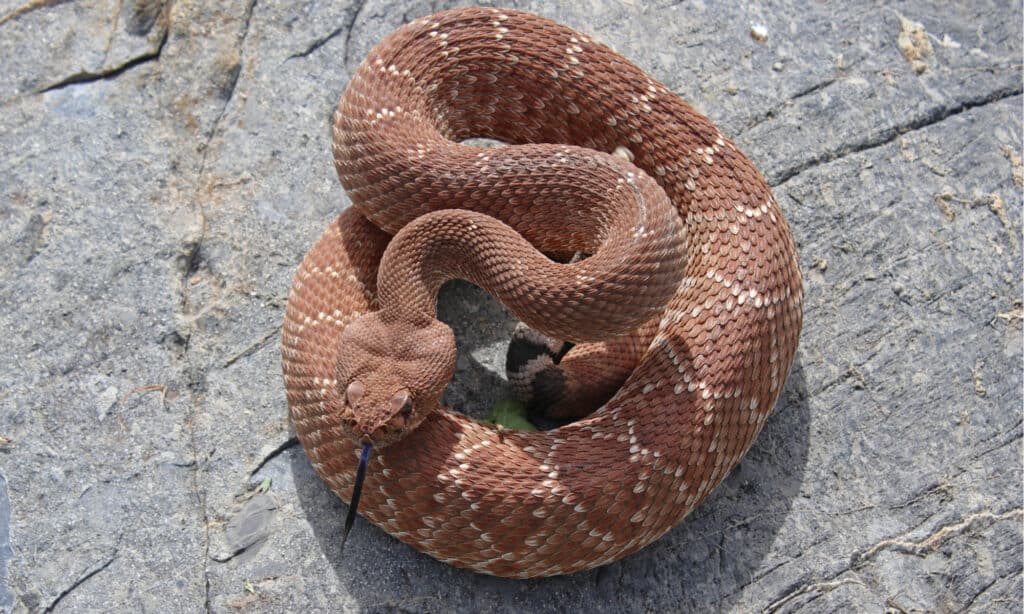
©Creeping Things/Shutterstock.com
There are 3 subspecies of red diamond rattlesnake. Most of the subspecies are differentiated by where they live. For example, the Cedros Island red diamond rattlesnake is only found on Cedros Island.
- Cedros Island red diamond rattlesnake (Crotalus ruber exsul)
- San Lucan red diamond rattlesnake (Crotalus ruber lucasensis)
- Red diamond rattlesnake (Crotalus ruber ruber)
This snake is found in southwestern California as well as Baja California in Mexico. The medium-sized snake has less toxic venom than some rattlesnakes, but they deliver a larger amount of it.
- Scientific name: Crotalus ruber
- Other names: red rattlesnake, red diamond snake, red diamond-backed rattlesnake, red rattler, western diamond rattlesnake, Cedros Island diamond rattlesnake, Cedros Island rattlesnake
- They can eat prey as large as rabbits and ground squirrels
- The largest red diamond rattlesnake ever found was 64 inches long
- They are about 3 feet long on average
- They are easily identified by their red color with diamond pattern on their body, plus a tail with black and white striped rings
Mexican Rattlesnakes
18. Ángel de la Guarda Island Speckled Rattlesnake
This rattlesnake is only found on Isla Ángel de la Guarda in Mexico. In English, the name means Archangel Island. The 47-mile-long island is in the Gulf of California and is part of the state of Baja California. Even though it has a small habitat, it is well protected and abundant within its range. It used to be considered a subspecies of the speckled rattlesnake, but became recognized as its own species in 2015.
- Scientific name: Crotalus angelensis
- Other Names: Isla Angel rattlesnake
- They grow up to 55 inches long
- They eat lizards, small mammals, and birds
- They have only one predator on Isla Ángel de la Guarda: king snakes
19. Querétaro Dusky Rattlesnake

©aliguori / CC BY-SA 2.0 – License
This snake lives at higher elevations in central Mexico. The scientific name includes the word aquilis, which means eagle, because they live in the mountains where you might also find eagles. It gets its common name from the state in Mexico where they are often found: Querétaro. The venom of this snake is primarily hemotoxic, meaning it affects the blood. However, these snakes are somewhat shy and generally only bite if provoked.
- Scientific name: Crotalus aquilis
- Other names: Vibora de cascabel
- They average 20 inches long
- Their main diet consists of lizards, and they will also eat frogs and small rodents if needed
- Young Querétaro rattlesnakes eat insects
20. Dusky Rattlesnake
Dusky rattlesnakes are found on the Central Mexican Plateau in states including Jalisco, México, Nayarit, Pueblo, and Veracruz. It is a high altitude snake. It has been spotted as high up as 15,000 feet, but usually spends its time between 8,800 and 11,000 feet.
- Scientific name: Crotalus triseriatus
- Other names: Viborita de cascabel, Central Plateau dusky rattlesnake
- They grow up to 24 inches long
- Males are larger than females
- The largest dusky rattlesnake ever found was 26.9 inches
- They eat frogs, small rodents, crickets, and lizards
21. Mexican Dusky Rattlesnake
Mexican dusky rattlesnakes were a subspecies of dusky rattlesnake until about 2014, when scientists determined that it is indeed a separate species. They’re endemic to Mexico, in the mountains from Jalisco to Michoacan.
- Scientific name: Crotalus armstrongi
- Other names: Chiauhcoatl de Armstrong
- Small snakes, they measure up to 24 inches long
- Males are larger than females
- They eat frogs, small rodents, crickets, and lizards
22. Mexican West Coast Rattlesnake
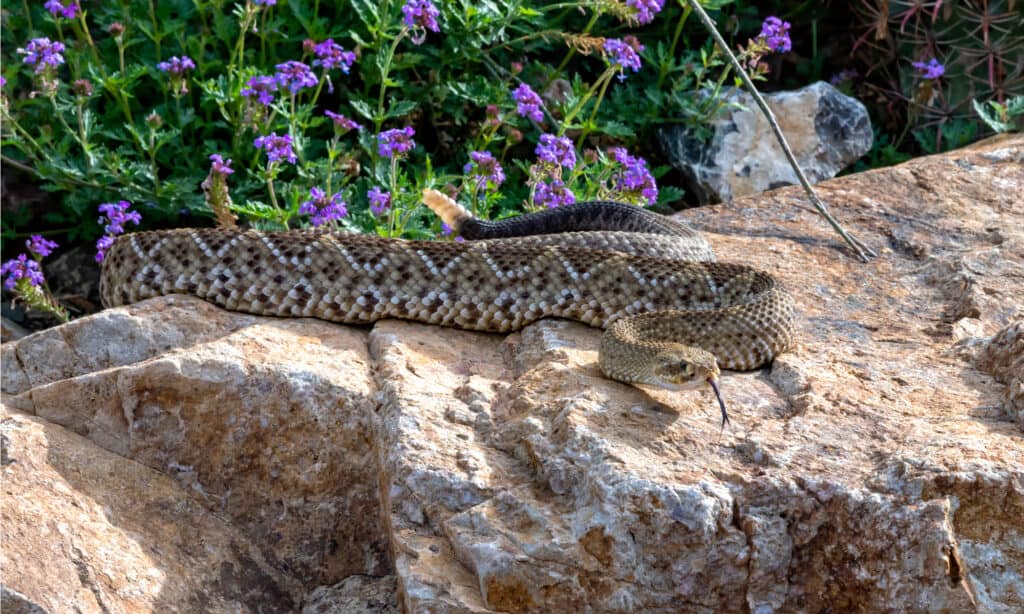
©Evelyn D. Harrison/Shutterstock.com
This is one of the larger rattlesnake species. They are found on the western coast of Mexico, ranging from Sonora to Michocoán. They mainly live in tropical and deciduous forests in this area. The venom of this rattlesnake is among the deadlier types. It is similar to that of the Mojave rattlesnake. They tend to deliver larger venomous loads with each bite than other types of rattlesnakes. Luckily, the Mexican Instituto Nacional de Higiene produces an antivenin that helps to reduce the severity of bites. A US-based company, BTG International, also produces an antivenin specific to this snake called Crotalidae Polyvalent Immune Fab (Ovine), or CroFab.
- Scientific name: Crotalus basiliscus
- Other names: Mexican green rattler, cascabel verde Mexicana
- This snake lives in the same habitat as the black-tailed rattlesnake and the two sometimes mate and create hybrids of the two species
- They often grow to be over 4.5 feet long
- The longest Mexican west coast rattlesnake ever found was 6.71 feet long
- This species of rattlesnake mostly eats small mammals
23. Santa Catalina Rattlesnake

©iStock.com/Jay Pierstorff
This rattlesnake species is only found on Isla Santa Catalina in Mexico. Another name for the island is Isla Catalina. The island is in the Gulf of California and is part of the state of Baja California, Mexico. No people live on the island and it is about 37 miles away from the nearest town, Loreto.
These snakes are quite good climbers. In the hottest months on the island, they will climb into low tree branches to get off the hot ground.
Unfortunately, the Santa Catalina rattlesnake is listed as critically endangered on the IUCN Red List. Part of the threat is because their habitat is so limited. The island they live on is only about 25 square miles. However, their numbers also suffer due to poaching, as well as the introduction of feral cats to the island.
- Scientific name: Crotalus catalinensis
- The Santa Catalina rattlesnake grows just over 2 feet long
- They eat mammals and lizards
- This rattlesnake species does not actually have a rattle
24. Campbell’s Rattlesnake
Campbell’s rattlesnake is found in the Mexican states of Jalisco, Nayarit, and Colima. It looks very similar to the dusky rattlesnake and shares some of the same habitat, but has a few defining characteristics that help to tell them apart. Campbell’s snakes have a smaller rattle, and they also have intercanthal scales, which are a certain type of scale on the head of a snake. The dusky rattlesnake does not have these scales.
- Scientific name: Crotalus campbelli
- Not much is known about this species
- It is named after Jonathan A. Campbell, a field researcher and professor who studied Mexican rattlesnakes closely.
25. Northwestern Neotropical Rattlesnake

©Rodolfo Ayala Plata/Shutterstock.com
This large rattlesnake is found in Southern Mexico near the country’s border with Guatemala. Not much is known about this species.
- Scientific Name: Crotalus culminatus
- Other names: Shunu
- It is about 3 feet long on average but can grow up to 5 feet long!
- Like most other rattlesnakes, the northwestern neotropical rattlesnake eats lizards, small mammals and birds
26. Tehuantepec Isthmus Neotropical Rattlesnake
Not much is known about this species of rattlesnake. They are larger than some other species. Even newborn specimens of this snake have been found with mammal remains in their intestines, showing they are big enough to feed on sizable animals even as babies. These animals displayed more activity in the summer than the fall or winter. Their habitat is primarily in Mexico.
- Scientific name: Crotalus ehecatl
- The scientific name comes from the Aztec god of wind, Ehēcatl, who was sometimes depicted as a serpent with feathers.
- A newborn specimen of this species was over one foot long
- Around 90% of their diet consists of small mammals like the West Mexican Cotton Rat, and the other 10% consists of birds like the Northern Bobwhite
27. Baja California Rattlesnake
This rattlesnake lives only in Baja California in Mexico as well as a few nearby islands. There are 3 subspecies:
- Lower California rattlesnake (Crotalus enyo enyo)
- Cerralvo Island rattlesnake (Crotalus enyo cerralvensis)
- Rosario rattlesnake (Crotalus enyo furvis)
What makes this rattlesnake unique is that they tend to eat the same kinds of foods no matter their size.
- Scientific name: Crotalus enyo
- A study found that this species of rattlesnake is more likely to hold onto its food after injecting them with venom than other species
- They eat lizards, centipedes, and rodents
28. Guerreran Long-Tailed Rattlesnake
This snake was only discovered in 2008. They have an incredibly long tail which equals 15% of their total length. They are found in a small area of the Mexican state of Guerrero.
- Scientific name: Crotalus ericsmithi
- The scientific name is in honor of Eric N. Smith, a biology professor at the University of Texas Arlington
- Since it is such a newly discovered species, more research is needed to learn about its behavior, size, and other details
29. Mexican Small-Headed Rattlesnake

©Alan Rockefeller / CC BY 4.0 – License
There are 3 subspecies of this rattlesnake, mostly determined by where they live and small variations in their scales:
- Totalcan small-headed rattlesnake (Crotalus intermedius intermedius)
- Oaxacan small-headed rattlesnake (Crotalus intermedius gloydi)
- Omilteman small-headed rattlesnake (Crotalus intermedius omiltemanus)
They tend to live in pine-oak forests but have also been seen in deserts. They prefer to live at elevations between 6,500 and 10,500 feet.
- Scientific name: Crotalus intermedius
- Other names: Viborilla
- They are about 22 inches long on average
- They can grow larger when in captivity
30. Autlán Rattlesnake
This snake has a very small habitat in just 2 Mexican states: Colima and Jalisco. The species was only found once 1966 and then was not seen again for over 40 years. It was identified from just one specimen, a dead female that was around 25 inches long. It was not found again until 2008 when it was “rediscovered.” Because of its rarity, not much is known about this species and more research is needed.
- Scientific name: Crotalus lannomi
- The scientific name is in honor of Joseph R. Lannom who first found the snake
- Experts believe they may be threatened by mining activities in the region
- There is not enough information available to identify their conservation status
31. Veracruz Neotropical Rattlesnake
This species was only named and specified in 2020. They live in dry forests in Veracruz, Mexico. Their venom is being studied because it is very powerful. It kills its small prey in seconds. However, a bite on a much larger animal (like a human) could be deadly, but may not have such a quick effect.
- Scientific name: Crotalus mictlantecuhtli
- The scientific name comes from the Aztec language Nahuatl and means “Lord of Mictlán” or “Lord of the Place of the Dead”
- They have been known to breed with the Western Diamondback Rattlesnake and create a hybrid species with a unique venom
32. Tamaulipan Rock Rattlesnake
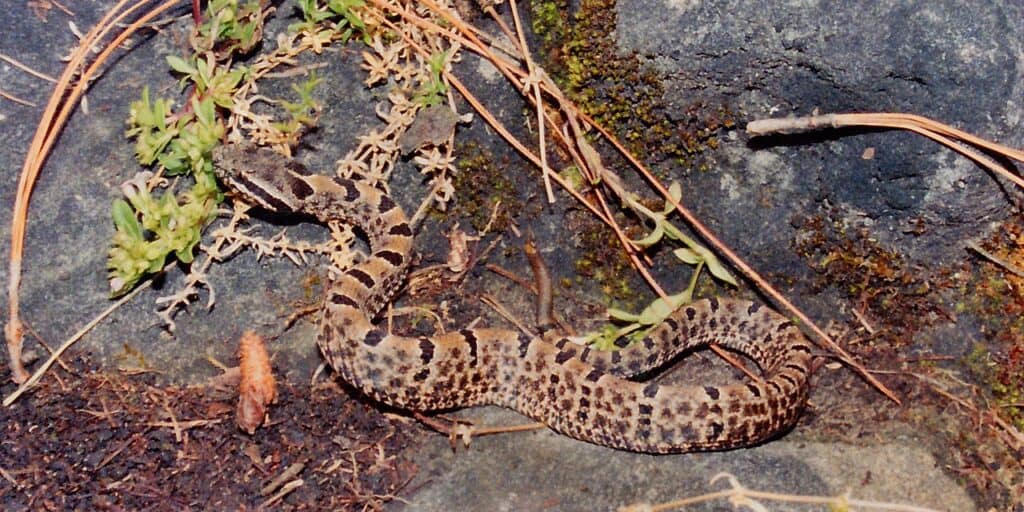
©William L. Farr / CC BY-SA 4.0 – License
This rattlesnake used to be a subspecies of the rock rattlesnake, but around 2014 it was labeled as its own species. It is named for the state of Tamaulipas where it is found.
What makes the Tamaulipan rock rattlesnake unique is its venom. It kills invertebrates more easily than vertebrates like mammals or lizards. Because of this, scientists believe they mostly eat centipedes.
- Scientific name: Crotalus morulus
- Other names: Cascabel Café de la Rocas
- A special compound found in the venom, morulustatin, may be used in the future for cancer drugs and drugs to reduce the risk of blood clots
33. Horsehead Island Speckled Rattlesnake
This is one of the smallest rattlesnake species in existence. They only grow to be about 1-2 feet long. They are only found on Horsehead Island in Baja, Mexico. In Spanish, the name of the island is Isla Cabeza de Caballo.
Experts believe they may be a smaller species because their habitat and available prey are both small. They feed only on lizards.
The scientific name is in honor of spider expert Gary A. Polis who died along with four other researchers when their boat capsized while returning from a research expedition to Isla Cabeza de Caballo. He is credited with saving the lives of surviving researchers and research assistants.
- Scientific name: Crotalus polisi
- This species was only discovered in 2018
- Their only predators are carnivorous birds on the island
34. Mexican Lance-Headed Rattlesnake
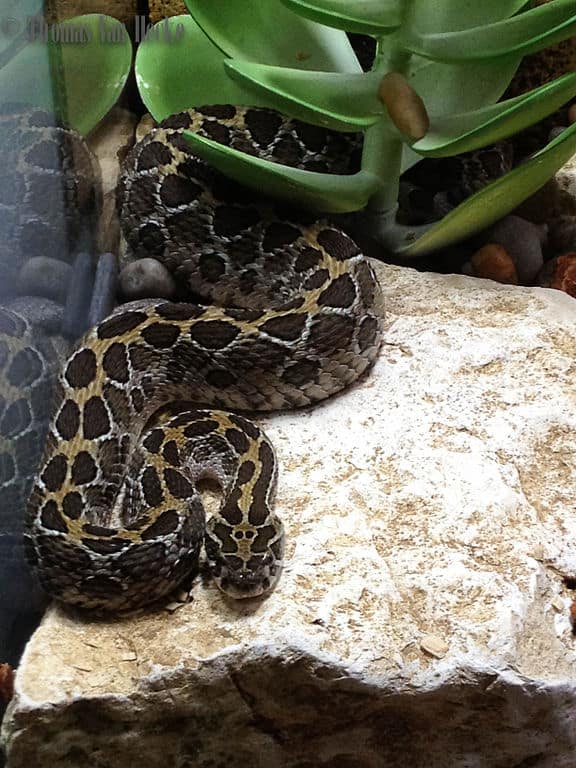
©Tomawak / CC BY-SA 3.0 – License
This one is not to be confused with the Mexican small-headed rattlesnake! They are 2 different species.
The Mexican lance-headed rattlesnake is found on the Central Mexican Plateau and likes to spend time in grasslands and scrublands. Their habitat has been reduced due to land clearing for farming. However, they are not an endangered species.
- Scientific name: Crotalus polystictus
- Venom from a young lancehead is more toxic than that from an adult
- Young lanceheads bite and hold their prey; adults bite them, let them go, and find them later
- They grow up to 28 inches long on average
- The largest Mexican lance-headed rattlesnake ever found was 39 inches long
35. Tancitaran Dusky Rattlesnake
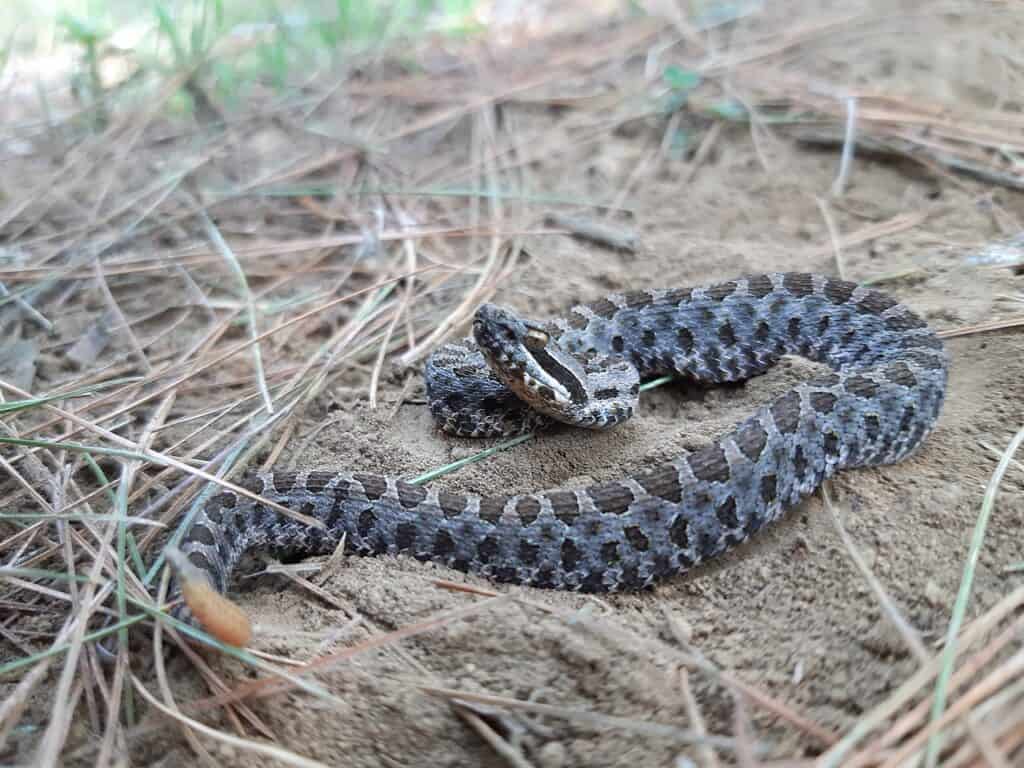
©Pillo Alcaraz / CC BY 4.0 – License
The Tancitaran dusky rattlesnake is listed as an endangered species. There are several factors that may lead to its extinction including a declining availability of its habitat due to human activity and volcanic activity in the area. Conservation efforts are underway to breed this rare species in captivity.
They are found in a few small areas of Mexico, mainly places with volcanic rock in the states of Michoacán and Jalisco.
- Scientific name: Crotalus pusillus
- They grow up to 20 inches long
- The largest Tancitaran dusky rattlesnake ever recorded was 26.9 inches long
- They are active only during the day
36. Mexican Pygmy Rattlesnake
There are 3 subspecies of the Mexican pygmy rattlesnake. They are mostly different due to their location.
- Oaxacan pygmy rattlesnake (Crotalus ravus brunneus)
- Guerreran pygmy rattlesnake (Crotalus ravus exiguus)
- Central Mexican pygmy rattlesnake (Crotalus ravus ravus)
As their name would suggest, they are a small variety of rattlesnakes. They are only between 16 and 26 inches on average. They are found in the southeastern section of the Mexican Plateau. They prefer altitudes between 4,500 and 10,000 feet.
Luckily, a bite from this snake is rare. They are not usually around humans and may prefer to slither away before rattling and biting. They can detect people or predators coming through vibrations and heat sensing and get away before they feel threatened.
- Scientific name: Crotalus ravus
- Other names: Mexican pygmy rattlesnake
- While it is listed as a species of least concern by the IUCN, the Mexican government has listed it as a “threatened” species
37. Sinaloan Long-Tailed Rattlesnake
This is one of the rarest rattlesnakes in the world. Only 12 specimens have ever been collected since it was discovered over 100 years ago in 1897. It is found in Nayarit, Sinaloa, and Durango Mexico between altitudes of 1,600 and 3,900 feet.
- Scientific name: Crotalus stejnegeri
- Other names: long-tailed rattlesnake
- This species is listed as vulnerable by the IUCN meaning it exists in 10 or fewer known locations and its population is likely on the decline
- Its rattle is so small you probably can’t hear it
38. Tancitaro Rattlesnake
Don’t confuse this one with the Tancitaran dusky rattlesnake. While they may be named after the same region, they do have some differences and are considered different species. It is found in the Tancitaro region of Michoácan.
- Scientific name: Crotalus tancitarensis
- There is not enough data to determine if it is endangered, but it seems to have a very small habitat
- The snake was first identified around 2004
39. Louse Island Speckled Rattlesnake
This species of rattlesnake is found only on Piojo Island in Baja California, Mexico. Piojo means lice in Spanish. This species is very good at blending in with its rocky surroundings. Their bodies are often the same color as the ground, with speckles and five distinct rings around the tail. Due to its small population and habitat, not much is known about this species.
- Scientific name: Crotalus thalassoporus
- The Louse Island speckled rattlesnake was only discovered in 2018
- Experts believe it came to the island during ancient water migrations
- The scientific name is Greek for seafarer
40. Tlaloc’s Rattlesnake
This snake is found in the Mexican states of Guerrero, Estado de México, Michoacán, and Morelos. It may also be present in Puebla. They live in pine-oak forests between elevations of 6,000 and 7,800 feet. One way to tell this species from others in the area is a distinctive dark stripe near the eye.
- Scientific name: Crotalus tlaloci
- The scientific name comes from Tláloc, the Aztec god of rain
- They have a very long tail that can be up to 11% of their body
41. Tortuga Island Diamond Rattlesnake
The Tortuga Island diamond rattlesnake is found only on Tortuga Island in the Gulf of California. The island is only 4 square miles and these snakes live all over, except in the volcanic crater on the island.
Some scientists consider it a subspecies of the western diamondback rattlesnake. However, others believe it has different enough characteristics to be its own species. It has a different, less prominent diamond pattern and a smaller head.
42. Totonacan Rattlesnake
- Scientific name: Crotalus tortugensis
- Other names: Tortuga Island rattlesnake
- They mainly eat the Dickey’s mouse, which is the only mammal on the island
- The rattlesnakes presence have caused people to avoid the island, contributing to the species’ largely undisturbed existence
- They range from 2-3.5 feet long
- Bites are rare because no one lives on Tortuga Island
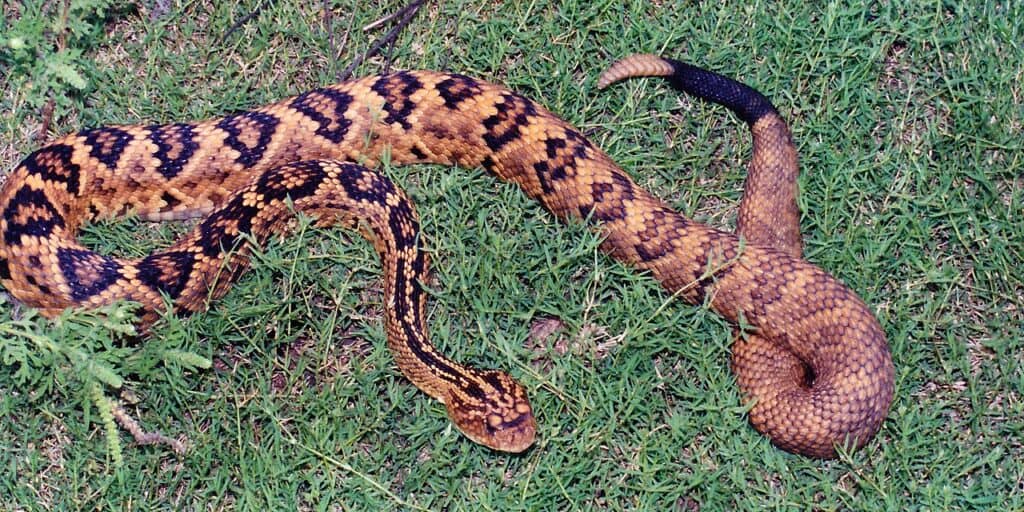
©William L. Farr / CC BY-SA 4.0 – License
This was once considered a subspecies of the South American rattlesnake. However, in 2014 it was granted its own status as a species. They are found in several central Mexican states including Nuevo Léon, Taumaulipais, Veracruz, San Luis Potosi, and Quéretaro. There is not much known about this species due to its rarity.
- Scientific name: Crotalus totonacus
- Other names: Tepocolciatl
- They grow up to 5 feet long
- The longest Totonacan rattlesnake ever found was 5 feet and 5 1/2 inches long
- The name comes from the indigenous Totonac people of Mexico
43. Cross-Banded Mountain Rattlesnake
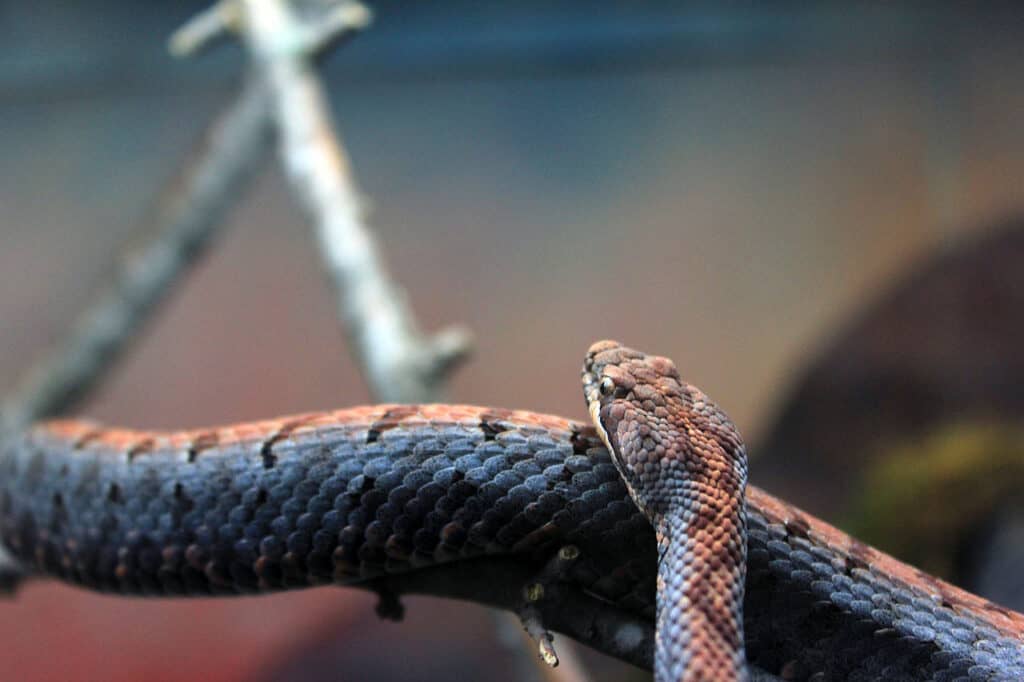
©Yinan Chen / Creative Commons – License
This is another rare type of rattlesnake, with fewer than 20 specimens available for study. They are rather small and are found in a small mountainous area in the Mexican states of México and Morales above elevations of 9,500 feet.
- Scientific name: Crotalus transversus
- Even though they are rare and have a small habitat, their population is stable and they are not endangered
- They are usually less than 2 feet long
44. Yucatan Neotropical Rattlesnake
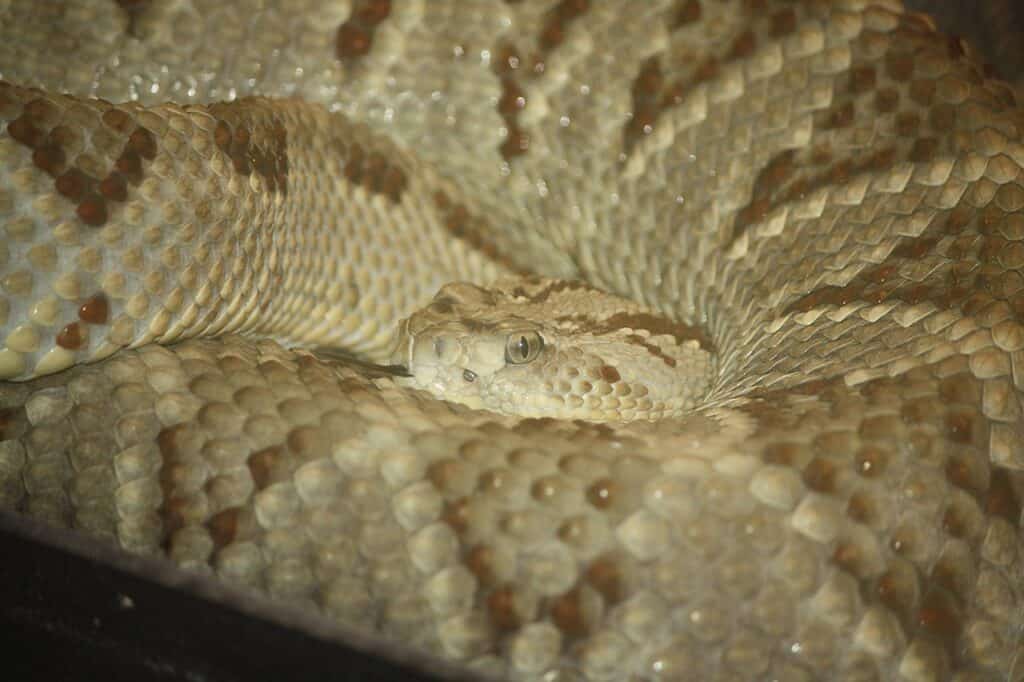
©Ltshears / CC BY-SA 3.0 – License
This has previously been listed as a subspecies of the South American rattlesnake and the Middle American rattlesnake. However, in 2014, it was decided that it should be its own species. It is found in Mexico, Guatemala and Belize.
- Scientific name: Crotalus tzabcan
- The scientific name comes from the Mayan word for rattlesnake
- They can grow up to 5 feet long
- The Yucatan neotropical rattlesnake has very toxic venom
Central American Rattlesnakes
45. Middle American Rattlesnake
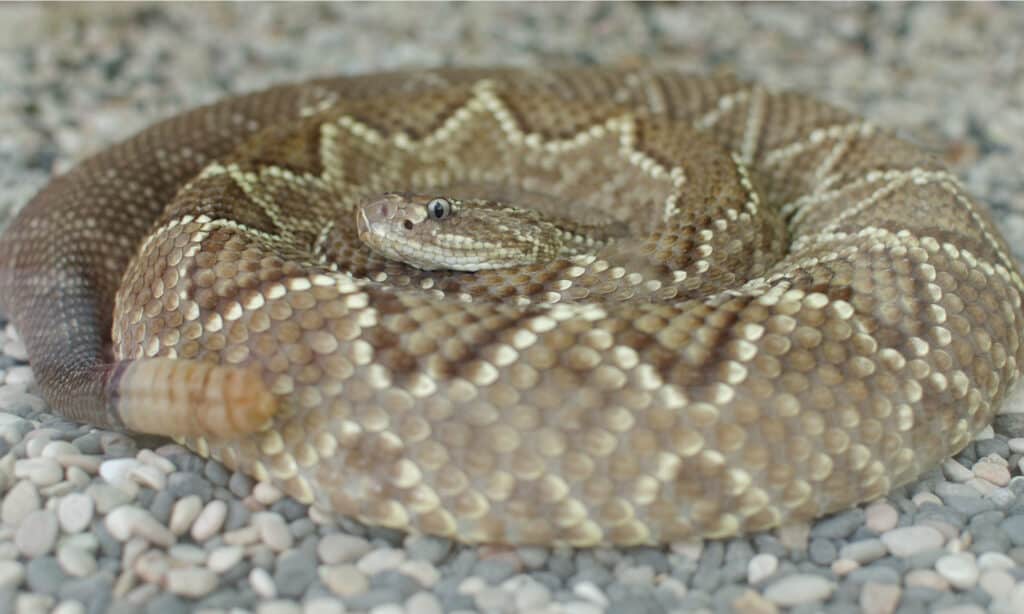
©edography/Shutterstock.com
This is one deadly viper. According to some sources, 75% of bites from a Middle American rattlesnake are fatal without medical treatment. Their venom damages the kidneys and can cause kidney failure just a few days after being bitten.
The Middle American rattlesnake used to be a subspecies of the South American rattlesnake. It also used to have several subspecies that have now been elevated to species status. Young Middle American rattlesnakes have very different venom from adults, making this species important to researchers.
They live all over Central America and are found from Mexico to Costa Rica and many places in between. They like dry environments, like dry rainforests and scrub forests.
- Scientific name: Crotalus simus
- Other names: Central American rattlesnake
- The Ancient Mayans created Middle American rattlesnake carvings in their temples
- They also ground dried snakes into powder for medicinal purposes
- They are most active at twilight
- They can grow up to 6 feet long
- The scientific name means “flat-headed”
South American Rattlesnakes
46. South American Rattlesnake
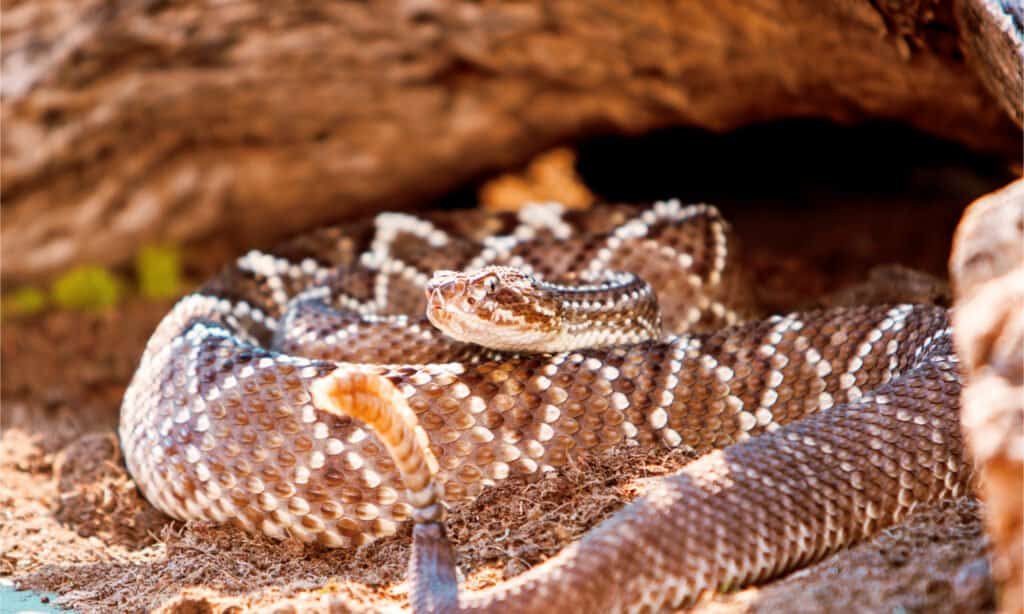
©GoodFocused/Shutterstock.com
There are 7 subspecies of the South American rattlesnake.
- Venezuelan rattlesnake (Crotalus durissus cumanensis)
- South American rattlesnake (Crotalus durissus durissus)
- Marajon rattlesnake (Crotalus durissus marajoensis)
- Cascavel (Crotalus durissus terrificus)
- Crotalus durissus maricelae
- Crotalus durissus ruruima
- Crotalus durissus trigonicus
This is the rattlesnake with the largest habitat. It ranges from Mexico all the way down to northern Argentina. However, there are some gaps in its habitat between northern South America and southern South America. They are also present on islands, including Aruba.
They are not an aggressive species but they will definitely bite if they feel threatened. It’s important to give any type of rattlesnake their space. Their bites are 72% deadly with no treatment and 11% fatal with treatment. Their venom is particularly harmful and causes blindness, paralysis, hearing issues, and systemic failure.
Despite its deadly potential, their venom does have a helpful quality: it has been shown to stop the virus hepatitis C in its tracks. Scientists are researching to see if the key to hepatitis C prevention could be found in South American rattlesnake venom.
- Scientific name: Crotalus durissus
- Other names: Cascabel Rattlesnake, Central American Rattlesnake, Aruba Island Rattlesnake, Cascabel-Tropische, Schauer-Klapperschlange, Zuid-Amerikaanse Ratelslang, Surinamse ratelslang, Rupununi Savanna Rattlesnake, Boicinim, Boicininga, Boiçununga, Boiquira, Cascabel, Cascavé, Cascavel, Cascavel-de-Quatro-Ventas, Cascavelha, Cobra-de-Chocalho, Cobra-de-Guizo, Cobra-do-Chocalho, Maracá, Maracaboia, Maracamboia, Surucucu-Cascavel
- They are most active at dusk and dawn
- They prey mostly on small mammals
- They are 5 feet long on average
- They can grow up to 6.2 feet long
Do all US States Have Rattlesnakes?

In case you need another reason to love Hawaii, they do not have rattlesnakes there.
©digidreamgrafix/iStock via Getty Images
It is a common misconception that all US states have rattlesnakes in their environments. In reality, this is not the case. In fact, rattlesnakes are not present in all states, and even those that do have them have specific areas where the species is more commonly found.
The states that do not have rattlesnakes are Hawaii, Alaska, Rhode Island, and Maine.
Are All Rattlesnakes Venomous?

Did you know that about 20 percent of the time, rattlesnakes do not inject venom when they bite?
©Chase D’animulls/Shutterstock.com
Rattlesnakes are a group of venomous serpents belonging to the genera Crotalus and Sistrurus of the subfamily Crotalinae. All species of rattlesnakes are venomous.
However, rattlesnakes do not inject venom in all of their bites. When they bite, they only inject venom 60-80 percent of the time. But when they do inject venom, it is lethal to small animals and can be dangerous to humans if not treated properly. Their venom, which is called hemotoxic, is designed to break down tissue.
The photo featured at the top of this post is © Viktor Loki/Shutterstock.com
Discover the "Monster" Snake 5X Bigger than an Anaconda
Every day A-Z Animals sends out some of the most incredible facts in the world from our free newsletter. Want to discover the 10 most beautiful snakes in the world, a "snake island" where you're never more than 3 feet from danger, or a "monster" snake 5X larger than an anaconda? Then sign up right now and you'll start receiving our daily newsletter absolutely free.
Sources
- Wikipedia, Available here: https://en.wikipedia.org/wiki/Timber_rattlesnake
- Kids Britannica, Available here: https://kids.britannica.com/students/article/twin-spotted-rattlesnake/313925
- California Herps, Available here: https://californiaherps.com/snakes/pages/c.o.oreganus.html
- Florida Museum, Available here: https://www.floridamuseum.ufl.edu/florida-snake-id/snake/dusky-pygmy-rattlesnake/
- University of Florida Wildlife, Available here: https://ufwildlife.ifas.ufl.edu/snakes/pygmyrattlesnake.shtml
- U.S. Fish & Wildlife Service, Available here: https://www.fws.gov/species/massasauga-sistrurus-catenatus
- Save the Buzztails, Available here: https://www.savethebuzztails.org/species-accounts/Isla-Angel-Rattlesnake
- Reptile Knowledge, Available here: http://www.reptileknowledge.com/squamata/dusky-rattlesnake.php
- Crofab, Available here: https://crofab.com/about-crofab/mechanism-of-action?utm_source=google&utm_medium=cpc&utm_campaign=crofabbrandexpanded&gclid=CjwKCAjw3K2XBhAzEiwAmmgrAmXGMWWCOvDiaPEBuFqPbVurgsvrpLhUHQ5J2mWwId-fahJxOEYXXBoCJwAQAvD_BwE
- Reptile Database, Available here: https://reptile-database.reptarium.cz/species?genus=Crotalus&species=campbelli
FAQs (Frequently Asked Questions)
How many kinds of rattlesnakes are there?
There are 45 species of rattlesnakes. Within those species, there are over 50 subspecies.
Which rattlesnake species are found in North America?
Timber rattlesnake, eastern diamondback rattlesnake, western diamondback rattlesnake, twin spotted rattlesnake, western rattlesnake, pygmy rattlesnake, ridge-nosed rattlesnake, sidewinder, massasauga rattlesnake, rock rattlesnake, Mojave rattlesnake, speckled rattlesnake, black-tailed rattlesnake, Panamint rattlesnake, tiger rattlesnake, prairie rattlesnake, and red diamond rattlesnake are all found in North America.
How many types of rattlesnakes are found in Mexico?
There are 26 individual species of rattlesnakes found in Mexico.
How many rattlesnake species are in South America?
There is only one rattlesnake species in South America: The South American rattlesnake.
Thank you for reading! Have some feedback for us? Contact the AZ Animals editorial team.






